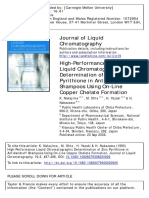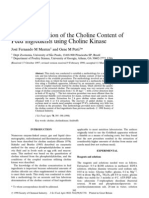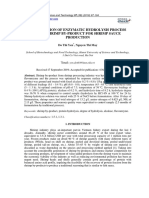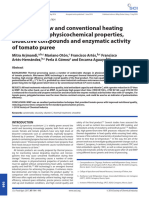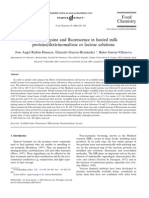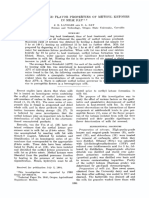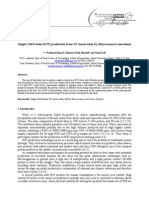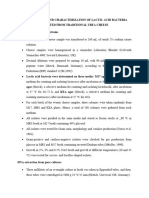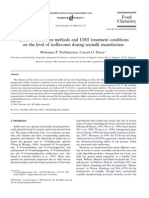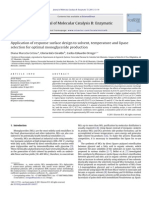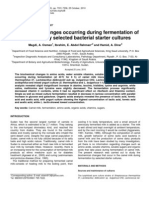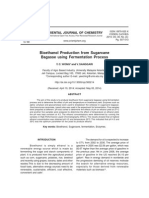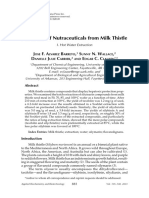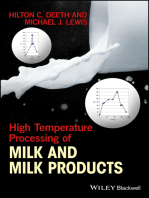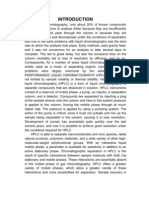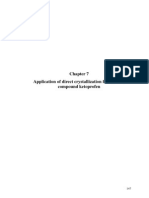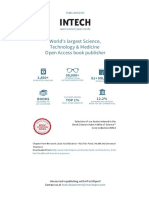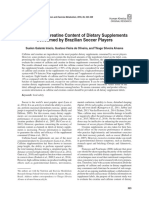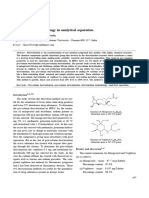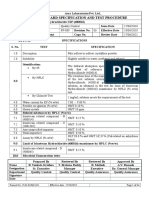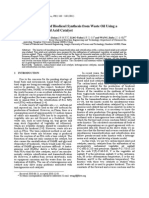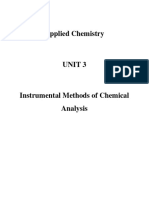Vitb1 B2
Vitb1 B2
Uploaded by
gbahaciuCopyright:
Available Formats
Vitb1 B2
Vitb1 B2
Uploaded by
gbahaciuOriginal Title
Copyright
Available Formats
Share this document
Did you find this document useful?
Is this content inappropriate?
Copyright:
Available Formats
Vitb1 B2
Vitb1 B2
Uploaded by
gbahaciuCopyright:
Available Formats
J Sci Food Agric 1998, 77, 473478
Effect of Thermal Processing on Available Lysine, Thiamine and Riboavin Content in Soymilk
Kin-Chor Kwok,1 Yui-Wah Shiu,1 Chi-Hung Yeung1 and Keshavan Niranjan2*
1 Department of Applied Biology and Chemical Technology, The Hong Kong Polytechnic University, Hung Hom, Kowloon, Hong Kong 2 Department of Food Science and Technology, The University of Reading, Whiteknights, PO Box 226, Reading, RG6 6AP, UK
(Received 6 June 1997 ; revised version received 24 October 1997 ; accepted 2 December 1997)
Abstract : Soymilk was heated over a range of temperatures (90140C) and times (06 h). The available lysine, thiamine and riboavin content of the soymilk samples were determined. There was no signicant change in available lysine during a 3 h heating period at 95C. At elevated temperatures of 120 and 140C, optimum heat processed soymilk gave higher measured values of available lysine than did soymilk processed at 95C. Prolonged heating at 120 and 140C caused a decline in available lysine. Kinetic data on the thermal degradation of thiamine and riboavin in soymilk were tted with rst-order kinetics and the kinetic parameters were determined. ( 1998 SCI. J Sci Food Agric 77, 473478 (1998) Key words : soymilk ; available lysine ; thiamine ; riboavin ; thermal processing
INTRODUCTION A major source of nutritive loss during processing is the deterioration in protein quality caused by nonenzymatic Maillard browning. Maillard browning primarily involves the reaction of free amino groups and reducing sugars. The majority of the free amino groups participating in the reaction are the e-amino groups of the essential amino acid lysine. If the e amino acid group is blocked through chemical bonding, the aected lysine residue in the protein becomes unavailable for use in the body for protein synthesis. Although lysine is present in fairly high concentrations and may not be the growth-limiting amino acid in the proteins of soymilk, the extent of its loss may provide an index of general heat damage to the nutritional quality of the soymilk protein. Kwok and Niranjan (1995) have reviewed the eect of thermal processing on the protein quality and vitamins in soymilk. It has been shown that there is a high correlation between available lysine content in
* To whom correspondence should be addressed. Contract/grant sponsor : Research Committee of Hong Kong Polytechnic University, Contract/grant number : 340/658.
soymilk protein and protein efficiency ratio (PER) once the antinutritional factors in soymilks have been inactivated by heating and drying under various conditions (Van Buren et al 1964 ; Hackler et al 1965). Hackler and Stillings (1967) noted that the highest PER value for soymilk processed at 121C is greater than the best PER value for soymilk processed at 93C. It has also been reported that soymilk produced by direct steam processing, using rapid hydration hydrothermal cooking (RHHTC) at temperatures of 121154C, had a higher reactive lysine value and nutritional properties than that produced by traditional methods (Hung 1984 ; Kim 1989). All these results suggest that heat treatment at high temperatures under optimum conditions may result in better protein quality. The amounts of thiamine and riboavin in soymilk are comparable to those in cows milk. Thiamine is water soluble and is one of the most unstable vitamins to moist heat treatment. Dierent processes involved in soymilk production such as soaking and blanching of the soybeans, and the subsequent heat treatments may lead to the loss of thiamine. Miskovsky and Stone (1987) compared the thiamine retention in soymilk processed by RHHTC, a high temperature (121154C) 473
( 1998 SCI.
J Sci Food Agric 00225142/98/$17.50.
Printed in Great Britain
474 short time direct steam-infusion cooking method, with soymilk processed by the traditional extraction method which involved cooking the soy our slurry at 99C for 60 min. RHHTC soymilk was found to contain a higher concentration of thiamine. The greater retention was attributed to a shorter period of exposure to heat. No signicant dierences were found in riboavin between the two soymilks indicating that it is less heat sensitive. The purpose of this study was to investigate the kinetics of the thermal degradation of available lysine, thiamine and riboavin in soymilk processed over a range of temperature (90, 120 and 140C) and time (0 180 min.)
K-C Kwok et al 05 ml of 1 M NaHCO and 1 ml of 1% trinitro3 benzenesulphonic acid (TNBS) (Sigma Chemical Co, St Louis, MO, USA) were added and the mixture incubated for 75 min at 40C. At the end of the incubation period, 30 ml of 11 M HCl was added. The reaction mixture was hydrolysed in a boiling water bath for 2 h. After ltering through Whatman no 42 lter paper and diluting to 10 ml, a 4-ml aliquot of the hydrolysate was extracted with two 5-ml volumes of diethyl ether. After removing the ether layer, the aqueous layer was diluted to 10 ml and the absorbance was measured at 415 nm. Pure L-lysine monohydrochloride (Aldrich Chemical Co, Gillingham, UK) was used as a standard.
MATERIALS AND METHODS Preparation of soymilk Canadian No 1 soybeans (Glycine max) were soaked in water (bean-to-water, 1 : 10) for 14 h at 5C. The soaked beans, along with the soaked water, were blended in a Waring blender at low speed for 5 min. The slurries were ltered through a nylon lter bag. The insoluble residue was discarded and the ltrate, containing about 65% total solids, was used in the experiments. Heat treatment of soymilk Heat treatments of soymilk were carried out in stainless-steel capillary tubes of 2 mm internal diameter, 056 mm wall thickness, and 6 m length, corresponding to a holding capacity of about 22 ml. The tubes were spiral-coiled with a valve at each end. The capillary tubes, which had a thin wall and large surface area, were highly efficient in heat transfer. The tubes were lled with soymilk using the suction created by a water aspirator. The lled tubes, with the valves closed, were immersed in a water bath for temperatures below 100C, or in polyethylene glycol for higher temperatures. The heating temperatures and times cover a range from 90 to 140C and 0 to 180 min, respectively. At the end of the heating time, the tubes were immediately transferred to a cold water bath. The time required to heat up the soymilk in the tubes to temperatures between 90 and 140C varied between 6 and 9 s, while, for cooling, it took 37 s. Thus, the heatingup and cooling-down times were negligible in comparison with the holding time. Determination of available lysine Available lysine was determined by the method of Hall et al (1973). The soymilk sample was diluted three times with deionised water. The 05 ml of the diluted soymilk,
Determination of thiamine and riboavin The high-performance liquid chromatographic (HPLC) method to determine thiamine and riboavin in soy products, developed by Fernando and Murphy (1990), was modied. The soymilk samples were lyophilized in a laboratory freeze-drier for 48 h and the dried samples were stored in screw-cap test tubes at 5C until use. About 06075 g of freeze-dried soymilk solids were reconstituted in 10 ml deionized water. The mixture was stored at 5C for 15 h for complete hydration. The solution was adjusted to pH 2 with 5 M HCl and autoclaved at 121C for 15 min to hydrolyse the protein-bound vitamins without causing heat damage. The pH of the cooled sample was increased to 45 by 1 M NaOH to isoelectrically precipitate most of the proteins. The sample was centrifuged at 5000 ] g for 5 min, and ltered through Whatman no 42 lter paper. The ltrate was made up to 25 ml with deionised water, reltered through 045-km membrane lter, and used in the quantitation of riboavin via HPLC or subjected to oxidation for thiamine analysis followed by HPLC analysis. The oxidised thiamine solution was neutralised by concentrated H PO to ensure a pH level acceptable 3 4 to the C column. The vitamins were separated and 18 quantied by HPLC on a reversed-phase C system 18 (Rainin 5 lm RP-18 Microsorb-MV 100A column) with uorescence detection (Dynamax FL-1 detector). The vitamins were monitored uorimetrically at 436 nm excitation and 536 nm emission for riboavin ; 360 nm excitation and 426 nm emission for thiochrome. The mobile phase was 15 mM sodium acetate in 40% methanol, pH 55, instead of acetonitrile, to increase the polarity in order to give a better separation. The standard curves were prepared from thiamine hydrochloride and riboavin standards (Sigma). Thiamine and riboavin standard solutions were injected into the HPLC system and the peak areas in the chromatogram were recorded. Linearity was observed in the chromatographic response to the concentration of the vitamin. The linear regression equation of the calibration curve obtained for thiamin was
Eect of thermal processing on soymilk y \ 3574x ] 088 (r \ 0997), and that for riboavin was y \ 3766x [ 005 (r \ 0995), where y is the peak area and x is the concentration of the vitamin in mg kg~1. Recovery efficiency was analyzed by spiking samples with 50 ll of the standard stock solutions of thiamine (100 mg kg~1) and riboavin (50 mg kg~1).
475
TABLE 1 Eect of heat treatment on the available lysine content in soymilk (mean ^ SD, n \ 3) T emperature (C) 95 Heating time (min) 0 30 60 90 120 150 180 0 10 20 30 40 50 0 1 3 5 7 10 Available lysine (g per 16 g N) 518 ^ 013 519 ^ 015 528 ^ 015 512 ^ 016 502 ^ 016 519 ^ 012 516 ^ 005 506 ^ 012 595 ^ 017 593 ^ 014 585 ^ 007 570 ^ 015 542 ^ 019 517 ^ 010 506 ^ 021 563 ^ 006 558 ^ 026 522 ^ 010 478 ^ 016
RESULTS AND DISCUSSION Eect of thermal processing on available lysine content in soymilk The TNBS method of Kakade and Liener (1969), revised by Hall et al (1973), for determining available lysine was chosen after reviewing the literature for procedures available and after preliminary trials. Concon (1975) developed a spectrophotometric method for the determination of lysine in cereal grains without hydrolysis of the sample. This procedure is based on the reaction of dinitrobenzenesulphonate (DNBS) which, under prescribed conditions, is quite specic for the e-amino groups of proteins or free lysine. The method of Concon required less time but suered from poor repeatability when applied to the determination of available lysine in soymilk. The TNBS method of Hall yielded values of available lysine in soymilk protein similar to reported literature values with reasonably good reproducibility so this method was used throughout this study. The available lysine content in soymilk, subjected to various degrees of heat treatment, is given in Table 1. When heating was prolonged at 95C, there was no signicant change in available lysine. This result is in agreement with the work of Van Buren et al (1964) and Hackler et al (1965) who reported that little change took place in the available lysine content of soymilk during a 6 h heating period at 93C. When the heating temperatures were elevated to 120C and 140C, there was a marked initial increase in available lysine followed by a gradual decline on prolonged heating. The initial rise in available lysine is somewhat surprising since protein damage caused by heat is usually accompanied by a decline in available lysine. These results, however, can be explained by the complicated quaternary structure of the 7S and 11S globular proteins in soymilk. The chemical structure and heat-induced phenomena of soybean proteins have been reviewed by Yamauchi et al (1991). It is known that the 7S (bconglycinin) and 11S (glycinin) fractions are made up of subunits which undergo association and dissociation reversibly. These changes are aected by factors such as temperature, pH, and ionic strength. Heating causes dissociation of both 7S and 11S into subunits. Further heating causes interaction between the dissociated subunits of 7S and 11S to form a soluble polymerised
120
140
aggregate and insoluble precipitate. The available lysine content measured in soymilk protein is aected not only by the amount of free e-amino groups of lysine but also by the extent of dissociation and association of the 7S and 11S globulins induced by heat. Chemical reactions such as the Maillard reaction and cross linking between polypeptide chains by acylation of free amino groups will result in a decrease in available lysine. On the other hand, heat-induced unfolding and dissociation of the globulins may have higher measured available lysine values than those of the native, unheated proteins because of the greater accessibility of the test reagent. Khaleque and Wallace (1975) found that the nutritive value (available lysine, available essential amino acids and pepsin digestibility) of soymilk samples prepared by the carbonate presoaking procedure was higher than that of the standard sample prepared from beans presoaked in water and processed at 115C for 18 min. The higher availability of lysine and the higher pepsin digestibility of the proteins from carbonate presoaked preparations are possibly due to the unfolding of the protein molecule as a result of the combined action of heat and alkali, thus enabling more amino groups to become available to react with the test reagent and also favouring enzymic attack. Since soy protein is compactly folded and a high intensity of heat treatment is necessary to unfold the protein molecule completely, it is possible that some e-amino groups may be buried within the protein molecule and thus may be unable to react with the test reagent (TNBS). It appeared that heating at 95C and moderate heating at 120 and 140C
476 caused little damage to the available lysine in soymilk. This is probably due to the fact that soluble sugars in soybeans are mainly sucrose, raffinose and stachyose, all of which are non-reducing sugars. The low reducing sugar content makes the loss of available lysine due to Maillard reactions insignicant when soymilk is moderately heated. On the other hand, heating at high temperatures (120 and 140C) greatly facilitated the unfolding and dissociation of the globulins, exposing more free amino groups of lysine at the molecular surface, and hence resulted in higher measured values. With prolonged heating at these high temperatures, the unfolded protein molecules interact to form aggregates, blocking the free amino groups of lysine, and therefore decreased the measured available lysine values. These results conform with the work of Van Buren et al (1964) who found that the optimum heat processed soymilk at 121C gave higher values of available lysine than did soymilk processed at 93C. It is interesting to note that, in this present study, the maximum available lysine value reached is higher at 120C than at 140C. This is probably due to the greater extent of protein aggregation and/or chemical reactions taking place on prolonged heating at 140C. It has been shown that the available lysine content correlated signicantly with the biological value (PER) (Van Buren et al 1964 ; Hackler et al 1965) and the pepsin digestibility (Khaleque and Wallace 1975) of heat-processed soymilk. The results in this study showed that the available lysine content in soymilk can be maximized, and the protein quality and digestibility improved, by proper control of processing temperature and time. Among the three dierent temperatures and the various heating times investigated, heating soymilk at 120C for 1020 min gave highest available lysine content.
K-C Kwok et al 244 mg kg~1 soymilk solids, respectively. The rate of destruction curves for thiamine and riboavin in soymilk heated at dierent temperatures are shown in Figs 1 and 2. Each data point on these graphs represents the mean of two duplicate runs. The linear behaviour of the semi-log plots suggested that the thermal degradation of thiamine and riboavin in soymilk is rst order in nature. From the slopes of the straight lines (obtained by linear regression analysis), the interaction rate constants at each temperature were calculated. The reciprocal of the slope of
Fig 1. Rate of destruction curves for thiamine in soymilk. (| : 90C, L : 120C, K : 140C)
Eect of thermal processing on thiamine and riboavin in soymilk The percentage recovery in the HPLC analysis, based on the mean and standard deviation of 12 determinations, were found to be 75 ^ 6 and 71 ^ 6 for thiamine and riboavin, respectively. The data show that there are some losses of the vitamins. It should be noted that the recovery studies only test the efficiency of recovery of pure compounds, but do not measure the efficiency of extraction from the sample. High protein content of soymilk and occlusion of vitamins in the protein precipitate may account for the incomplete recovery. The thiamine and riboavin contents in soymilk were calculated from the concentrations detected in the HPLC analysis divided by the % recovery. The thiamine and riboavin contents of raw soymilk were determined to have an average value of 1406 and
Fig 2. Rate of destruction curves for riboavin in soymilk. (| : 90C, L : 120C, K : 140C)
Eect of thermal processing on soymilk the straight line is the decimal reduction time (D value), which is the time for 90% destruction of the vitamin in soymilk at the specied temperature. The D value can also be related to the rst-order reaction rate constant : D \ 2303/k. The calculated values for k and D, as shown in Table 2, represent the heat stability of these vitamins in soymilk. Figure 3 gives the thermal destruction time curves for thiamine and riboavin in soymilk as plots of the logarithm of the D values against the corresponding temperatures. The curves appeared to be straight lines, which were tted with linear regression analysis. From the reciprocal of the slopes of these curves, the Z values (temperature dierence in C eecting a 10-fold change in D) were determined to be 30C and 36C for thiamine and riboavin, respectively. The eect of temperature on the destruction of thiamine and riboavin can also be studied in terms of the Arrhenius equation :
477
TABLE 2 Reaction rate constants (k) and decimal reduction time (D) for thermal degradation of thiamine and riboavin in soymilk V itamin T emperature (C) 90 120 140 90 120 140 k (min~1) 132 ] 10~3 129 ] 10~2 666 ] 10~2 705 ] 10~4 426 ] 10~3 212 ] 10~2 D (min)
Thiamine
Riboavin
1745 178 35 3268 540 109
ln k \ ln k [ E /RT 0 a in which k is the reaction rate constant, T the absolute temperature, R the gas constant, E the activation a energy and k the frequency factor. The Arrhenius plot, 0 in which ln k is plotted against the reciprocal of the absolute temperature, is shown in Fig 4. The linearity of the plot indicates the conformity of the experimental data with the Arrhenius equation. From the slopes and intercepts of the Arrhenius plot, E and k were calcua 0 lated. Both E and Z characterize the temperature a dependence of the reaction. The kinetic parameters k , 0 E , Z were determined to be 113 ] 1011 min~1, a 970 kJ mol~1 and 30C for thiamine ; and 687 ] 108 min~1, 833 kJ mol~1 and 36C for riboavin, respectively. Studies on the kinetics of the thermal degradation of thiamine in food products have been reported by earlier investigators. Mulley et al (1975) described the thermal degradation of thiamine in buered solution (pH 6), and in pea puree, beef puree and peas-in-brine puree with rst-order kinetics and E values were calculated to be a in the range 113123 kJ mol~1 (27294 kcal mol~1). However, some workers observed deviations from rst order reactions. Mulley et al (1975) attributed the deviations to the heating equipment used by some workers which could not be operated under ideal conditions. The lag periods for come-up and cooling times could have introduced errors. In this study, the use of a capillary stainless steel tube for heating soymilk greatly facilitated the heat transfer. The more precise control of the heating temperature and time in this experiment resulted in more accurate kinetic data, and therefore
Fig 3. Relationship between decimal reduction time (D value) and heating temperature for thermal degradation of thiamine and riboavin in soymilk. (L : thiamine, | : riboavin)
Fig 4. Arrhenius plot for thermal degradation of thiamine and riboavin in soymilk. (L : thiamine, | : riboavin)
478 rst order kinetics were observed. Kessler and Fink (1986) tted the kinetic data on the thermal decomposition of thiamine in cows milk with a second order reaction kinetics and determined the kinetic parameters k 0 and E to be 514 ] 1011 min~1 and 1008 kJ mol~1, a respectively. These values are in close agreement with those for thiamine degradation in soymilk, as determined in this study, probably due to the fact that dairy milk and soymilk are similar in chemical composition. As compared to thiamine, thermal degradation of riboavin in soymilk was found to have greater D values (or smaller k) (Table 2) and smaller E (or larger a Z), implying that riboavin is more heat stable and less temperature sensitive than thiamine. Therefore, thiamine is a more critical nutrient factor to control during thermal processing. From the experimental results, about 12%, 32% and 3% of the thiamine was lost in soymilk processed at 90C for 60 min, 120C for 15 min and 140C for 30 s, respectively, indicating the superiority of UHT heat treatment in maximizing vitamin retention. However, in the design of an optimum thermal process for soymilk, apart from maximising vitamin retention, the following conditions should also be obtained simultaneously : maximum destruction of bacterial spores, maximum destruction of antinutritional factors, maximum protein quality and minimum degradation of sensory quality. Under these constraints, some loss of vitamin is an inevitable consequence of thermal processing.
K-C Kwok et al rst-order kinetics. Thiamine was found to be much more heat sensitive than riboavin. The kinetic parameters k , E and Z were determined to be 0 a 113 ] 1011 min~1, 970 kJ mol~1 and 30C for thiamine ; and 687 ] 108 min~1, 833 kJ mol~1 and 36C for riboavin, respectively.
ACKNOWLEDGEMENT This work was supported by the Research Committee of Hong Kong Polytechnic University (Grant No 340/ 658).
REFERENCES
Concon J M 1975 Rapid method for the determination of lysine in cereal grains without hydrolysis. Anal Biochem 66 460480. Fernando S M, Murphy P A 1990 HPLC determination of thiamin and riboavin in soybeans and tofu. J Agric Food Chem 38 163167. Hackler L R, Stillings B R 1967 Amino acid composition of heat-processed soymilk and its correlation with nutritive value. Cereal Chem 44 7077. Hackler L R, Van Buren J P, Streinkraus K H, El Rawi I, Hand D B 1965 Eect of heat treatment on nutritive value of soymilk protein fed to weanling rats. J Food Sci 30 723 728. Hall R J, Trinder N, Givens D I 1973 Observation on the use of 2,4,6-trinitrobenzene sulphonic acid for the determination of available lysine in animal protein concentrate. Analyst 98 673686. Hung J J 1984 Studies on processing, functional characteristics and nutritional quality of hydrothermal extracts of soybeans. PhD thesis, Kansas State University, KN, USA. Kakade M L, Liener I E 1969 Determination of available lysine in proteins. Anal Biochem 27 273280. Kessler H G, Fink R 1986 Changes in heated and stored milk with an interpretation by reaction kinetics. J Food Sci 51 11051111. Khaleque A, Wallace G M 1975 Studies on the processing and properties of articial milk. IV. Evaluation (in vitro) of nutritional quality of proteins in various heatprocessed soymilks. Bangladesh J Sci Industr Res 10 148157. Kim C J 1989 Physico-chemical, nutritional and avor properties of soybean extracts processed by rapid hydration hydrothermal cooking. PhD thesis, Iowa State University of Science & Technology IA, USA. Kwok K C, Niranjan K 1995 Review : Eect of thermal processing on soymilk. Int J Food Sci T echnol 30 263295. Miskovsky A, Stone M B 1987 Eects of processing on curd yield and nutrient composition of rapid hydration hydrothermal cooking and traditionally processed soymilk and soybean curd. J Food Sci 52 15421544. Mulley E A, Stumbo C R, Hunting W M 1975 Kinetics of thiamine degradation by heat. J Food Sci 40 985988. Van Buren J P, Streinkraus K H, Hackler L R, El Rawi I, Hand D B 1964 Heat eect on soymilkIndices of protein quality in dried soymilk. J Agric Food Chem 12 524528. Yamauchi F, Yamagishi T, Iwabuchi S 1991 Molecular understanding of heat-induced phenomena of soybean protein. Food Rev Int 7 283322.
CONCLUSIONS Heat treatment may cause an increase or decrease in the measured available lysine content of soymilk depending on the temperature and time used. Apparent increases may occur under optimum heating conditions due to the complete unfolding and dissociation of the soymilk protein, exposing more free e-amino groups of lysine at the molecular surface. On the other hand, severe heating causes protein aggregation and chemical reactions such as Maillard reactions and cross-linking of the unfolded peptide chains, resulting in a decrease in the available lysine content. It was found that heating at 95C for up to 3 h caused practically no change in available lysine in soymilk. Optimum heat processed soymilk at 120C and 140C gave higher measured values of available lysine than did soymilk processed at 95C. The highest available lysine was found in soymilk processed at 120C for 1020 min. Extensive heating at 120 and 140C caused a drop in available lysine. The available lysine content in heat-processed soymilk has a nutritional implication since it has been correlated with the biological value (PER) and the pepsin digestibility. The kinetic data on the thermal destruction of thiamine and riboavin in soymilk can be tted with a
You might also like
- Nakajima 1993Document12 pagesNakajima 1993Adrián Rojas ÁvilaNo ratings yet
- Effect of Sodium Chloride and Phosphates On The Thermal Properties of Chicken Meat ProteinsDocument5 pagesEffect of Sodium Chloride and Phosphates On The Thermal Properties of Chicken Meat Proteinszhaer001No ratings yet
- En 14372 Child Use and Care Articles - Cutlery and Feeding UtensilsDocument25 pagesEn 14372 Child Use and Care Articles - Cutlery and Feeding UtensilsLaura Marcela100% (1)
- Determination of CholineDocument4 pagesDetermination of Cholinerahul1809No ratings yet
- Effect of Different Physical and Chemical Treatments On Detoxification of Ricin in Castor CakeDocument10 pagesEffect of Different Physical and Chemical Treatments On Detoxification of Ricin in Castor CakeL D Mendoza UrbinaNo ratings yet
- Optimization of Enzymatic Hydrolysis Process From Shrimp By-Product For Shrimp Sauce ProductionDocument8 pagesOptimization of Enzymatic Hydrolysis Process From Shrimp By-Product For Shrimp Sauce ProductionNadie NingunoNo ratings yet
- 2017 MW Bioactive Quality Tomato Puree Arjmandi JSFADocument7 pages2017 MW Bioactive Quality Tomato Puree Arjmandi JSFAOmar IbrahimNo ratings yet
- Nutritional Composition and Solubility of Edible Bird Nest (Aerodramus Fuchiphagus)Document7 pagesNutritional Composition and Solubility of Edible Bird Nest (Aerodramus Fuchiphagus)garias indraNo ratings yet
- Purification and Characterization From Stearothermophilus: BacillusDocument6 pagesPurification and Characterization From Stearothermophilus: BacillusAnindya Rahma O KNo ratings yet
- Effect Heat To AaDocument8 pagesEffect Heat To AaVani pratamiNo ratings yet
- Potential of Taiwan Sorghum Spirits Lees For The Production of BioethanolDocument21 pagesPotential of Taiwan Sorghum Spirits Lees For The Production of Bioethanolrichardson sitohangNo ratings yet
- Ind 23218981Document4 pagesInd 23218981stilbeneNo ratings yet
- Thermophyical Properties of GuavaDocument5 pagesThermophyical Properties of Guavaclamarpi84No ratings yet
- 15 PDFDocument7 pages15 PDFPradeep PereraNo ratings yet
- (Enzyme Bromelain) Sonklin2011Document9 pages(Enzyme Bromelain) Sonklin2011Endah WulandariNo ratings yet
- Production of Low Acidity Rice Bran Oil by Heating ProcessDocument6 pagesProduction of Low Acidity Rice Bran Oil by Heating ProcessSahil KumarNo ratings yet
- 1,1-Diphenyl-2-Picrylhydrazyl (DPPH) Radical Scavenging by Protein Hydrolyzates From Tuna Cooking JuiceDocument6 pages1,1-Diphenyl-2-Picrylhydrazyl (DPPH) Radical Scavenging by Protein Hydrolyzates From Tuna Cooking JuiceDaniela UrreaNo ratings yet
- Effect of Heat Treatment On The Nutritional Quality of Milk ProteinsDocument4 pagesEffect of Heat Treatment On The Nutritional Quality of Milk ProteinsLộc Võ Tường100% (1)
- Rufian, Lys SMDocument8 pagesRufian, Lys SMJosé ContrerasNo ratings yet
- 89-Article Text-278-5-10-20151006Document8 pages89-Article Text-278-5-10-20151006Della AzzuraNo ratings yet
- L Angler 1964Document6 pagesL Angler 1964suongkookieNo ratings yet
- Cristalización CuajoDocument9 pagesCristalización CuajoPablo GarcíaNo ratings yet
- FPL 2011 Lee003Document9 pagesFPL 2011 Lee003Arif HidayatNo ratings yet
- Sundaran 2001Document6 pagesSundaran 2001dian212No ratings yet
- ProtibelDocument6 pagesProtibelAna Cláudia AlencarNo ratings yet
- Communications The Editor: Enhancement of Enzymatic Hydrolysis of Sugar Cane Bagasse by Steam Explosion PretreatmentDocument5 pagesCommunications The Editor: Enhancement of Enzymatic Hydrolysis of Sugar Cane Bagasse by Steam Explosion PretreatmentyaezasosaNo ratings yet
- Identification and Characterization of Lactic Acid BacteriaDocument4 pagesIdentification and Characterization of Lactic Acid BacteriaGeorge TwambaNo ratings yet
- Procedimiento ExperimentalDocument5 pagesProcedimiento ExperimentalSara CarrilloNo ratings yet
- 4 PinkrovaDocument9 pages4 PinkrovaNik AsriNo ratings yet
- Producción de Leche de SojaDocument7 pagesProducción de Leche de SojaDaniel Cambronero PedrazNo ratings yet
- Studies On The Preservation of Raw Cow's Milk by Chemical MethodDocument10 pagesStudies On The Preservation of Raw Cow's Milk by Chemical MethodOktalia Putri PratamaNo ratings yet
- Surucu1975 PDFDocument24 pagesSurucu1975 PDFMohammad Rifan TaufiqurrahmanNo ratings yet
- Protein Size Distribution and Inhibitory Effect of Wheat Hydrolysates On NeutraseDocument6 pagesProtein Size Distribution and Inhibitory Effect of Wheat Hydrolysates On NeutraseVirginia GiordanengoNo ratings yet
- 1application of Response Surface Design To Solvent, Temperature and Lipase Selection For Optimal Monoglyceride ProductionDocument7 pages1application of Response Surface Design To Solvent, Temperature and Lipase Selection For Optimal Monoglyceride ProductionKarliis MedinaNo ratings yet
- سلسلة بكتيريةDocument6 pagesسلسلة بكتيريةdads_love4799No ratings yet
- Liquid Chromatographic Determination of Vitamins B1 and B2 in Foods.Document6 pagesLiquid Chromatographic Determination of Vitamins B1 and B2 in Foods.Daniel Dávila MartinezNo ratings yet
- Torulaspora Delbrueckii and Conversion To Ephedrine byDocument4 pagesTorulaspora Delbrueckii and Conversion To Ephedrine bysalvia1025100% (1)
- Greene 1967 - Nylon 1313 Synthesis and Polymerization of MonomersDocument4 pagesGreene 1967 - Nylon 1313 Synthesis and Polymerization of MonomersRoy MustangNo ratings yet
- Effect of Temperature And/or Pressure On Lactoperoxidase Activity in Bovine Milk and Acid WheyDocument13 pagesEffect of Temperature And/or Pressure On Lactoperoxidase Activity in Bovine Milk and Acid WheyLoredana DumitrascuNo ratings yet
- Odongo - Tetty - Opiyo Et Al 2024Document7 pagesOdongo - Tetty - Opiyo Et Al 2024Sylvia OpiyoNo ratings yet
- A Simple and Rapid Method For Colorimetric Determination of Histamine in Fish FleshDocument8 pagesA Simple and Rapid Method For Colorimetric Determination of Histamine in Fish Fleshmuratout3447No ratings yet
- 3.0 Material and Methods: 3.1 Collection of Raw MaterialDocument24 pages3.0 Material and Methods: 3.1 Collection of Raw Materialmanish kumar monuNo ratings yet
- Microencapsulation of Caraway Extract in Β-cyclodextrinDocument6 pagesMicroencapsulation of Caraway Extract in Β-cyclodextrinDiego Javier CaicedoNo ratings yet
- Ultrasonic Inactivation of Soybean Trypsin InhibitorsDocument6 pagesUltrasonic Inactivation of Soybean Trypsin InhibitorsgeorgianaNo ratings yet
- Kinetic Studies of Wheat Straw Hydrolysis Using Sulphuric AcidDocument7 pagesKinetic Studies of Wheat Straw Hydrolysis Using Sulphuric AcidViviana GeraldinNo ratings yet
- Alim2 8Document9 pagesAlim2 8Miroljub BaraćNo ratings yet
- BioRes 07 2 1540 Ding HO Compar Pretreat Strat Coconut Husk Sugars 2491 PDFDocument8 pagesBioRes 07 2 1540 Ding HO Compar Pretreat Strat Coconut Husk Sugars 2491 PDFNatasha Mgt JoharNo ratings yet
- Jurnal BiotekDocument6 pagesJurnal BiotekAdry ShevchenkoNo ratings yet
- Amano P6 - Rice BranDocument6 pagesAmano P6 - Rice BranlaviniakartikaNo ratings yet
- Partial Characterization of Lipase From Cocoa BeanDocument6 pagesPartial Characterization of Lipase From Cocoa BeannubnubNo ratings yet
- E Ects of Hydrothermal Treatment On The Physicochemical Properties of Pregelatinized Rice FlourDocument9 pagesE Ects of Hydrothermal Treatment On The Physicochemical Properties of Pregelatinized Rice FlourBrianNo ratings yet
- Ts-1 Production of Flavouring Agent From Shrimp HeadsDocument8 pagesTs-1 Production of Flavouring Agent From Shrimp HeadsRemya PillaiNo ratings yet
- Methods Lignocellulosic Feedstock, Enzymes and YeastDocument7 pagesMethods Lignocellulosic Feedstock, Enzymes and YeastЮлия БратчикNo ratings yet
- Bioethanol Production From Sugarcane Bagasse Using Fermentation ProcessDocument7 pagesBioethanol Production From Sugarcane Bagasse Using Fermentation ProcessM Syafiq SamadNo ratings yet
- Optimization of The Process For Biodiesel Production Using A Mixture of Immobilized and LipasesDocument5 pagesOptimization of The Process For Biodiesel Production Using A Mixture of Immobilized and LipasesjhcastropNo ratings yet
- Bioetanol Por TrichodermaDocument7 pagesBioetanol Por TrichodermaJeah Gogh GoahhNo ratings yet
- Barreto 2003Document9 pagesBarreto 2003BarakatEtmanNo ratings yet
- LAboratory ProceduresDocument29 pagesLAboratory ProceduresNaji MajoudiNo ratings yet
- Advances in Dairy ProductsFrom EverandAdvances in Dairy ProductsFrancesco ContoNo ratings yet
- Application of HPLC in Pharmaceutical IndustriesDocument44 pagesApplication of HPLC in Pharmaceutical Industrieskapil dev80% (10)
- Detection of Aflatoxins in Milk at Picogram Levels Using SPE and LC-MS/MSDocument6 pagesDetection of Aflatoxins in Milk at Picogram Levels Using SPE and LC-MS/MSHelios AngelNo ratings yet
- Application of Direct Crystallization For Racemic Compound KetoprofenDocument47 pagesApplication of Direct Crystallization For Racemic Compound KetoprofenVinay BhayaNo ratings yet
- Standardization of Marketed Cystone Tablet: A Herbal FormulationDocument7 pagesStandardization of Marketed Cystone Tablet: A Herbal FormulationassemNo ratings yet
- JURNALDocument7 pagesJURNALElisaDwiRestianaNo ratings yet
- Jurnal Kimia Mulawarman, Vol.8, No.2 (2011), Hal. 70-73Document7 pagesJurnal Kimia Mulawarman, Vol.8, No.2 (2011), Hal. 70-73HizbullahNo ratings yet
- MAN Lactic Acid Bacteria in Philippine Traditional Fermented FoodsDocument19 pagesMAN Lactic Acid Bacteria in Philippine Traditional Fermented FoodsVincent ReyesNo ratings yet
- Oliveira Et Al 2015Document20 pagesOliveira Et Al 2015Valeria Barria AlvarezNo ratings yet
- Review of Analytical Methods: Hua YinDocument34 pagesReview of Analytical Methods: Hua YinNop PiromNo ratings yet
- Caffeine and Creatine Content of Dietary SupplementsDocument7 pagesCaffeine and Creatine Content of Dietary SupplementsVanessa BarrosNo ratings yet
- Chemosphere: Jin Soo Choi, Kanghee Kim, Kyungil Park, June-Woo ParkDocument9 pagesChemosphere: Jin Soo Choi, Kanghee Kim, Kyungil Park, June-Woo ParkM GolloNo ratings yet
- Derivatization Methodology in Analytical Separation: SP. Karuppiah and K. AnverbashaDocument4 pagesDerivatization Methodology in Analytical Separation: SP. Karuppiah and K. AnverbashaAK GAMINGNo ratings yet
- Man 4820 3601 LC Vanquish UHPLC Man48203601 ENDocument154 pagesMan 4820 3601 LC Vanquish UHPLC Man48203601 ENJosé Robson VenturimNo ratings yet
- RinchipaperDocument10 pagesRinchipaperpraveenpalanivel098No ratings yet
- Ketamine Can Be Produced by Pochonia Chlamydosporia - An Old Molecule and A New AnthelminticDocument9 pagesKetamine Can Be Produced by Pochonia Chlamydosporia - An Old Molecule and A New AnthelminticHamilton MorrisNo ratings yet
- FP-089 REV-06 - FinalDocument43 pagesFP-089 REV-06 - FinaljulekhabegumNo ratings yet
- Dionex Ionpac As19 Columns: Product ManualDocument40 pagesDionex Ionpac As19 Columns: Product ManualDr.Vinod SrivastavaNo ratings yet
- Dicorcia 2012Document6 pagesDicorcia 2012melania.irimiaNo ratings yet
- Benzoic Acid in Orange JuiceDocument1 pageBenzoic Acid in Orange JuiceAhmed GwealyNo ratings yet
- Dissolution Guide 2021 ENG 27-07-2021 WEB KleinerDocument56 pagesDissolution Guide 2021 ENG 27-07-2021 WEB KleinerosamamoselhyNo ratings yet
- Reaction Kinetics of Biodiesel Synthesis From Waste Oil Using A Carbon-Based Solid Acid CatalystDocument6 pagesReaction Kinetics of Biodiesel Synthesis From Waste Oil Using A Carbon-Based Solid Acid Catalystsalonso93No ratings yet
- Unit 3 Spectroscopy Notes PDFDocument59 pagesUnit 3 Spectroscopy Notes PDF7nx58s9dyhNo ratings yet
- HPLC E BookDocument40 pagesHPLC E BookCp Daksh100% (1)
- LWT - Food Science and Technology: A A B CDocument9 pagesLWT - Food Science and Technology: A A B CThuNo ratings yet
- Development and Validation of Stability Indicating Method For Simultaneous Estimation of Cefepime and Tazobactam Injection Using RP-UPLC MethodDocument8 pagesDevelopment and Validation of Stability Indicating Method For Simultaneous Estimation of Cefepime and Tazobactam Injection Using RP-UPLC MethodIOSR Journal of PharmacyNo ratings yet
- Nidhi-Tbi: National Initiative For Developing and Harnessing InnovationsDocument52 pagesNidhi-Tbi: National Initiative For Developing and Harnessing InnovationsshashiNo ratings yet
- A Chemical and Ethnopharmalogical Study On (Euphorbiaceae) : Phyllanthus EmblicaDocument64 pagesA Chemical and Ethnopharmalogical Study On (Euphorbiaceae) : Phyllanthus EmblicaMegi LimbaNo ratings yet
- Functions of BloodDocument5 pagesFunctions of BloodsecretNo ratings yet
